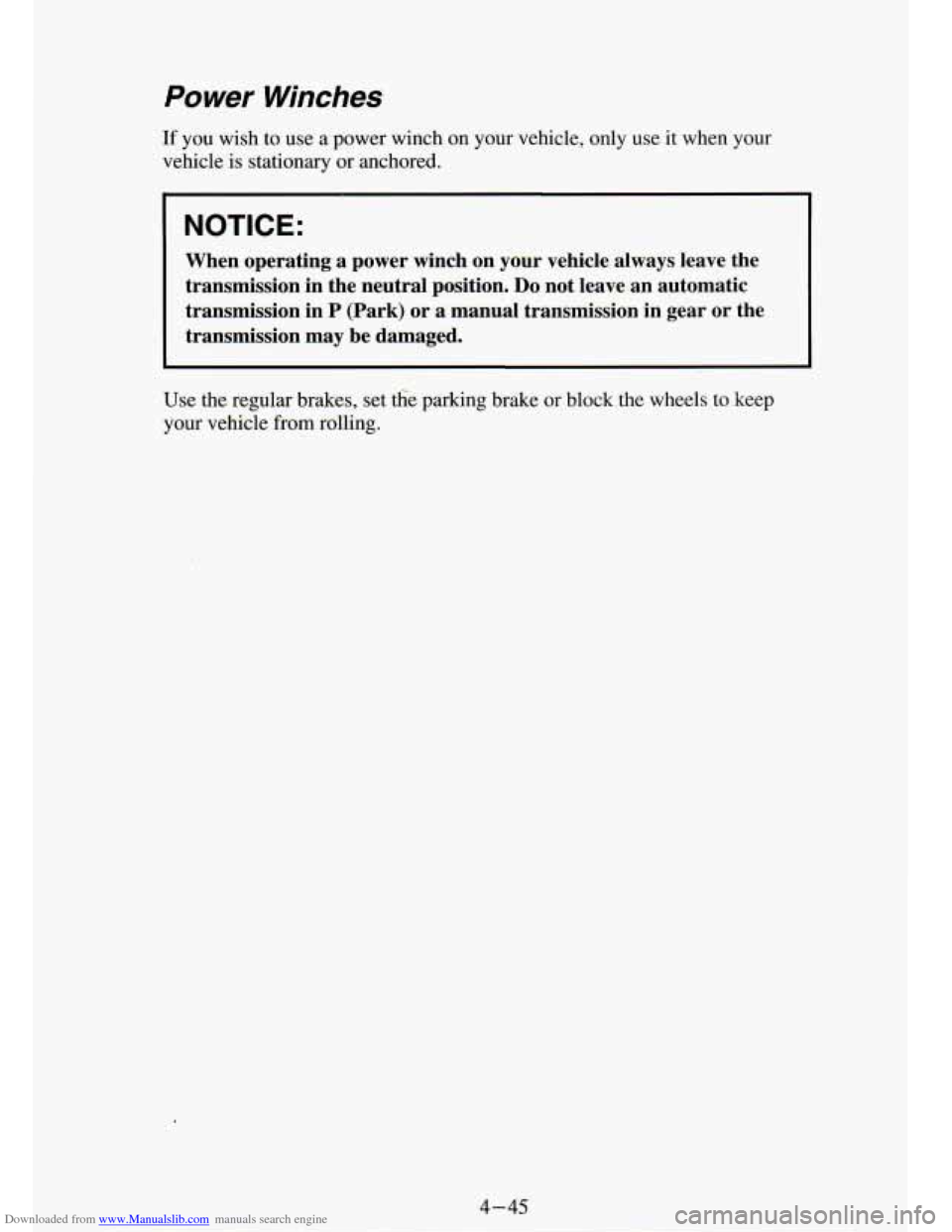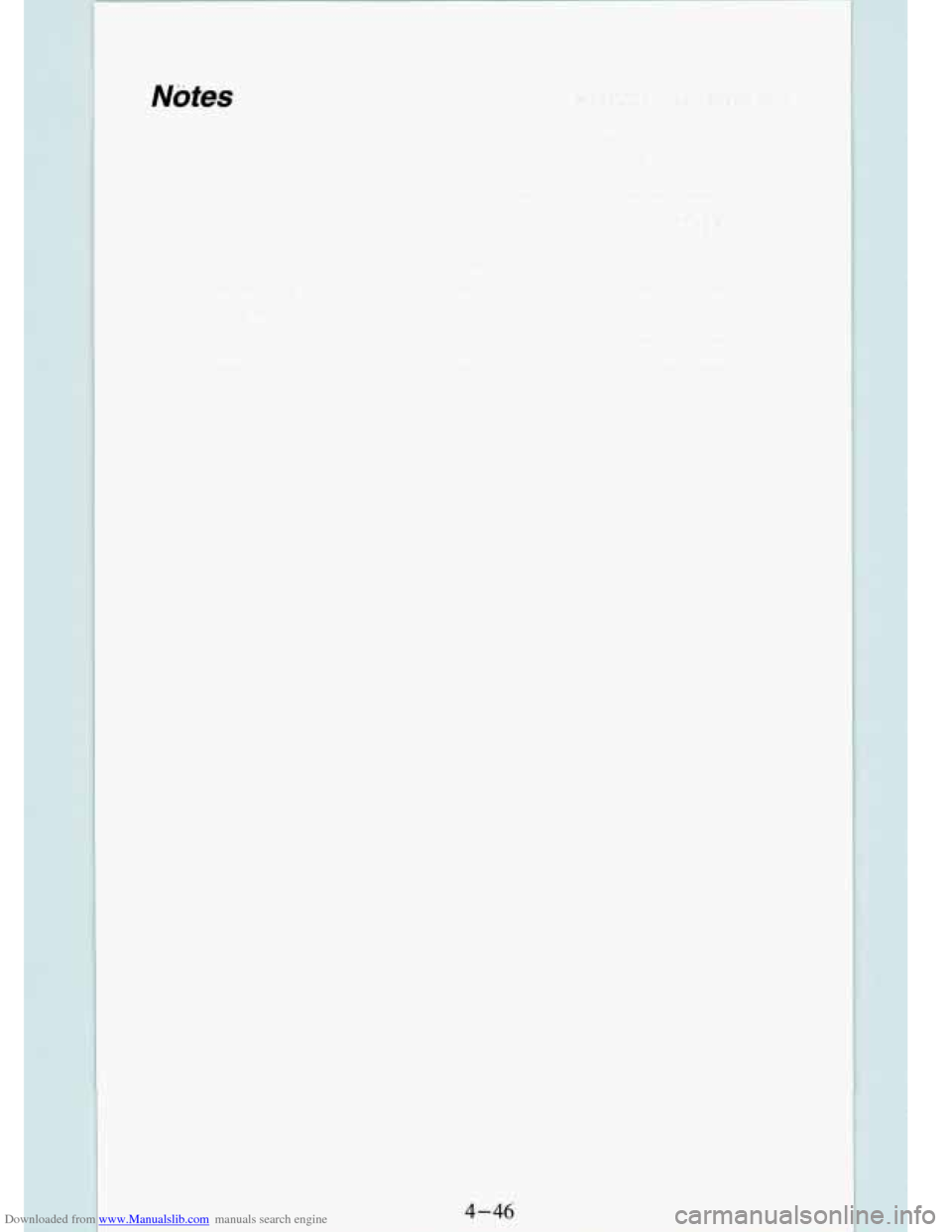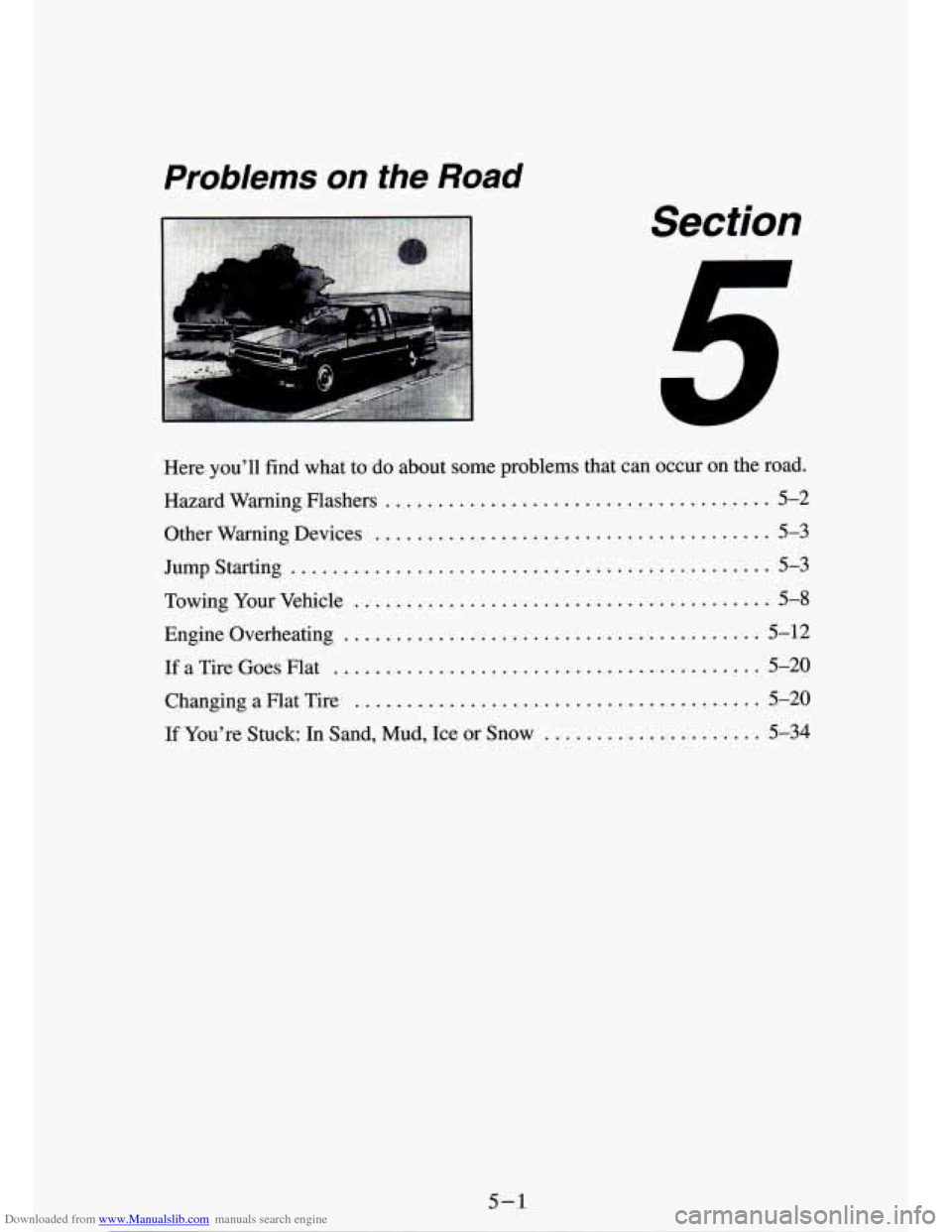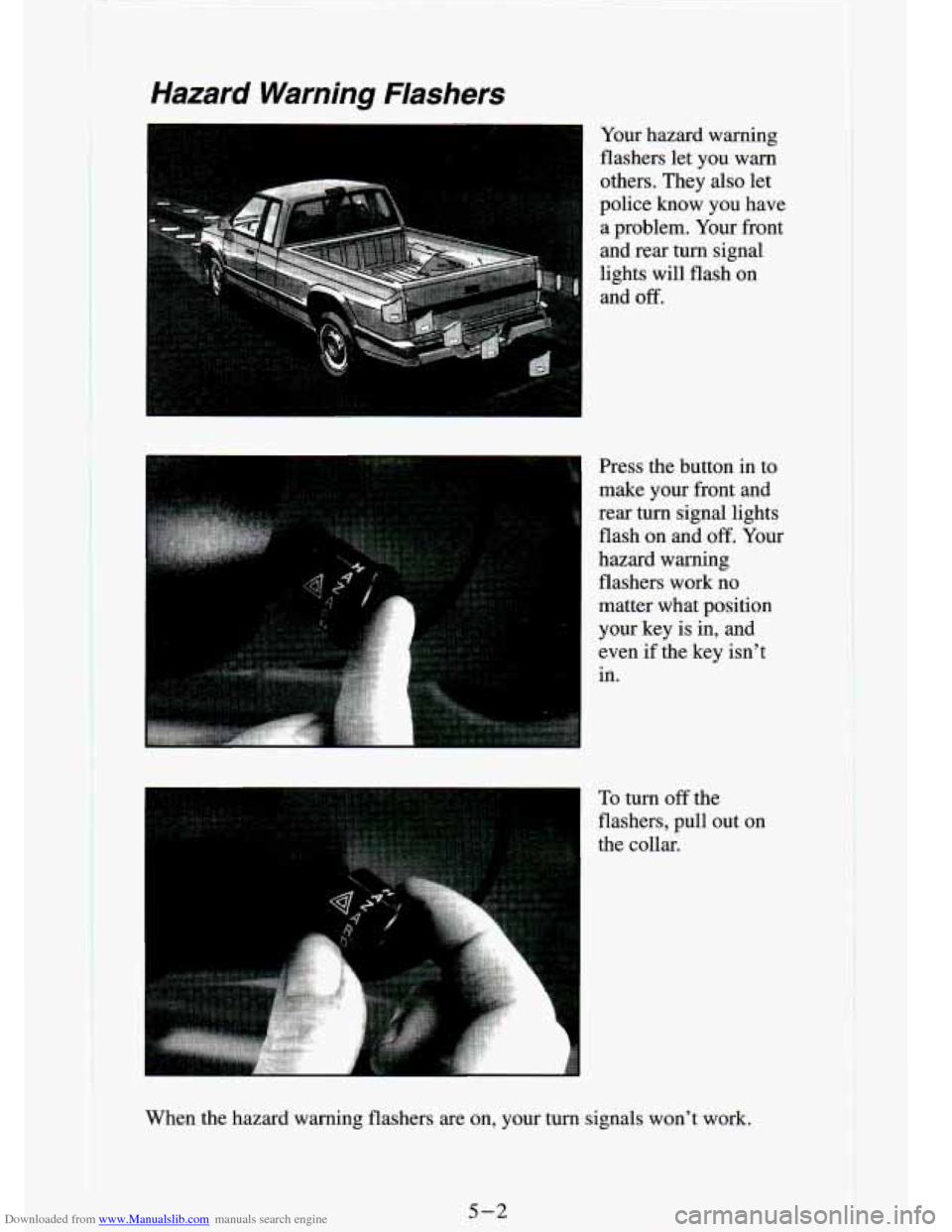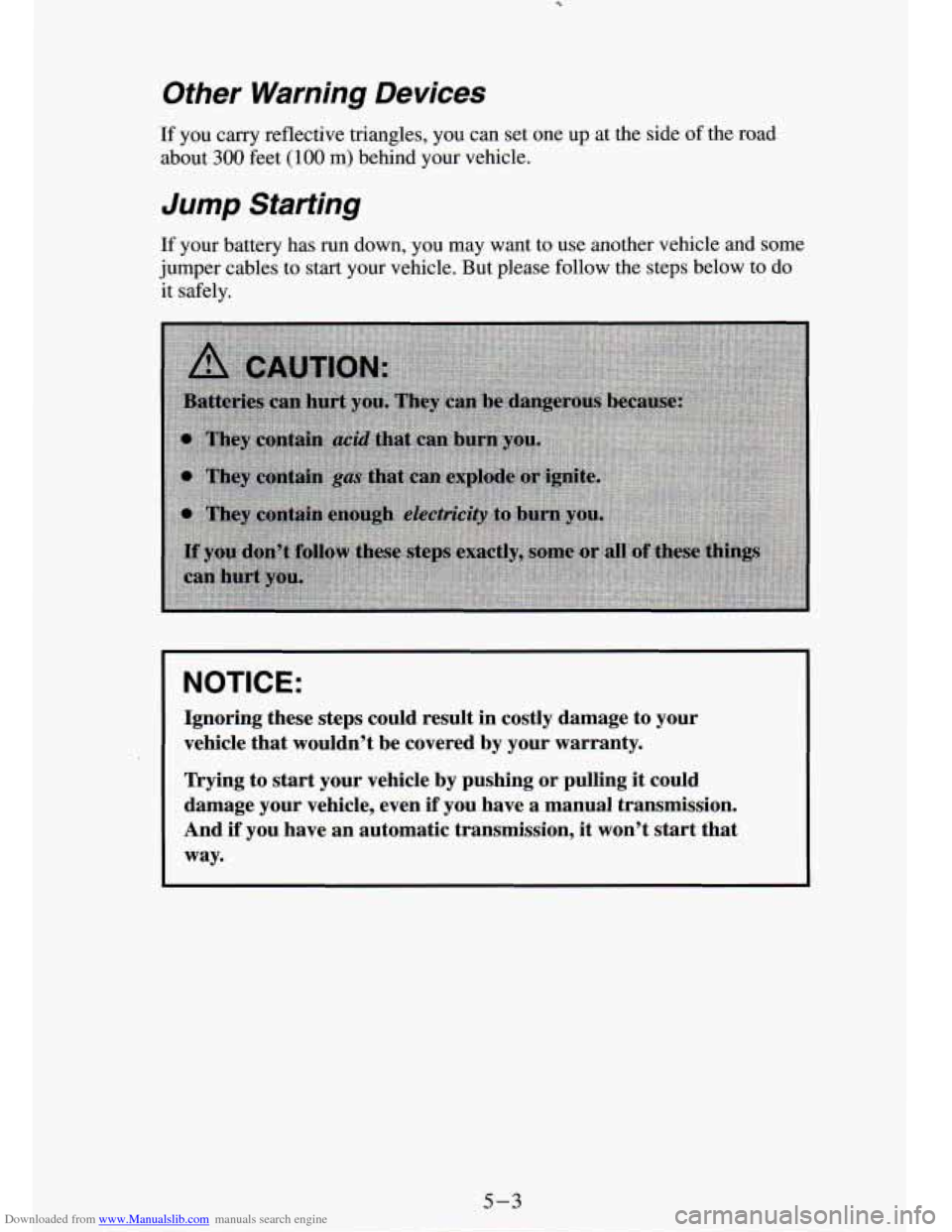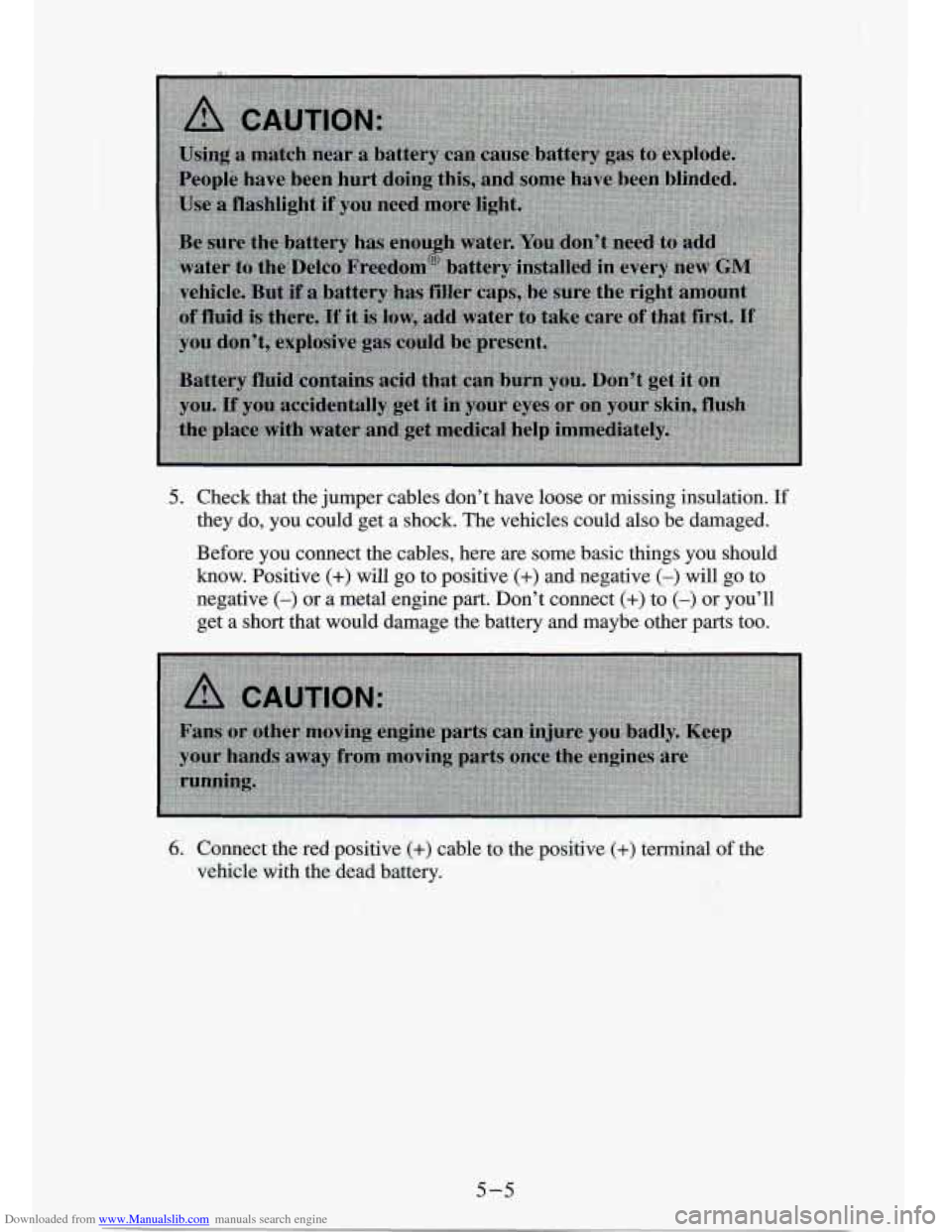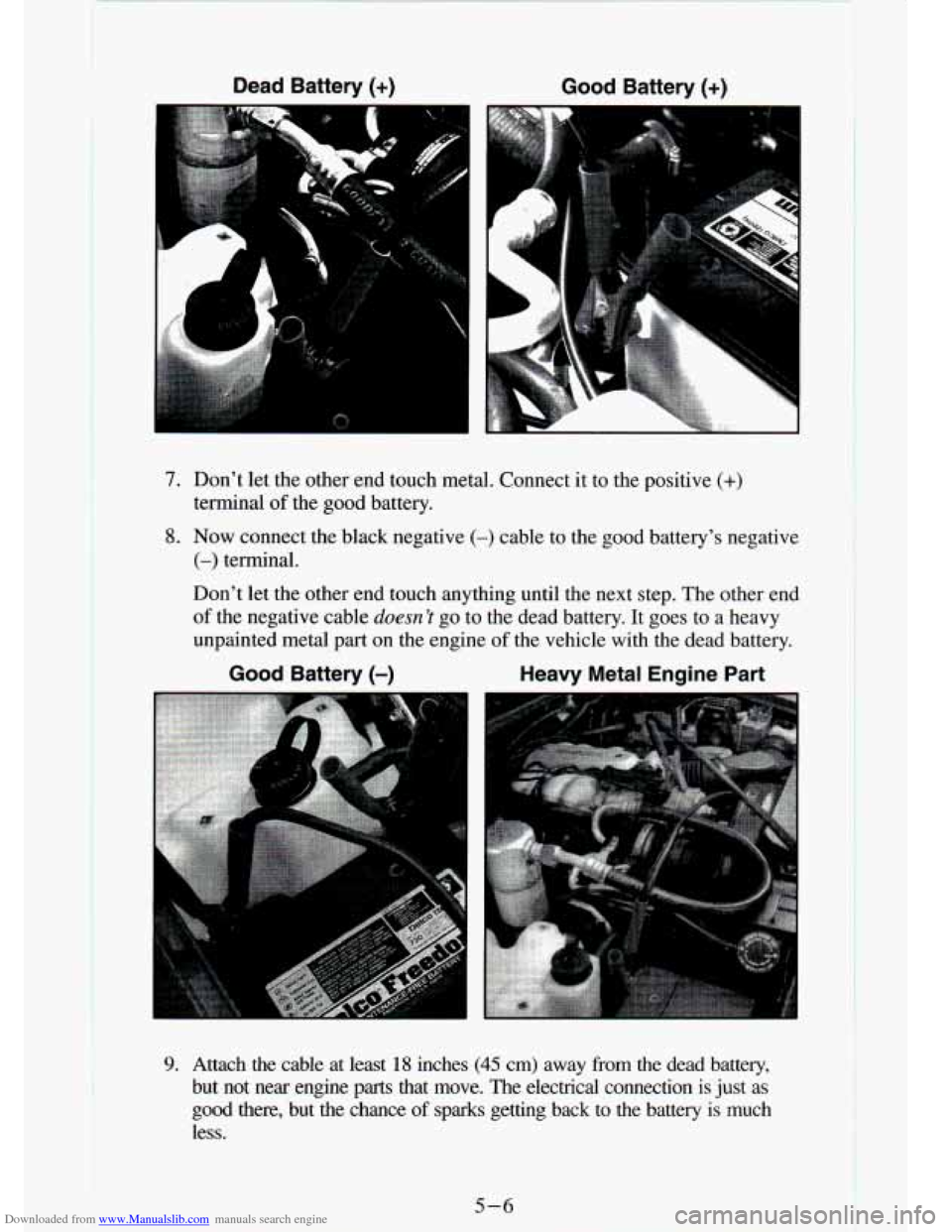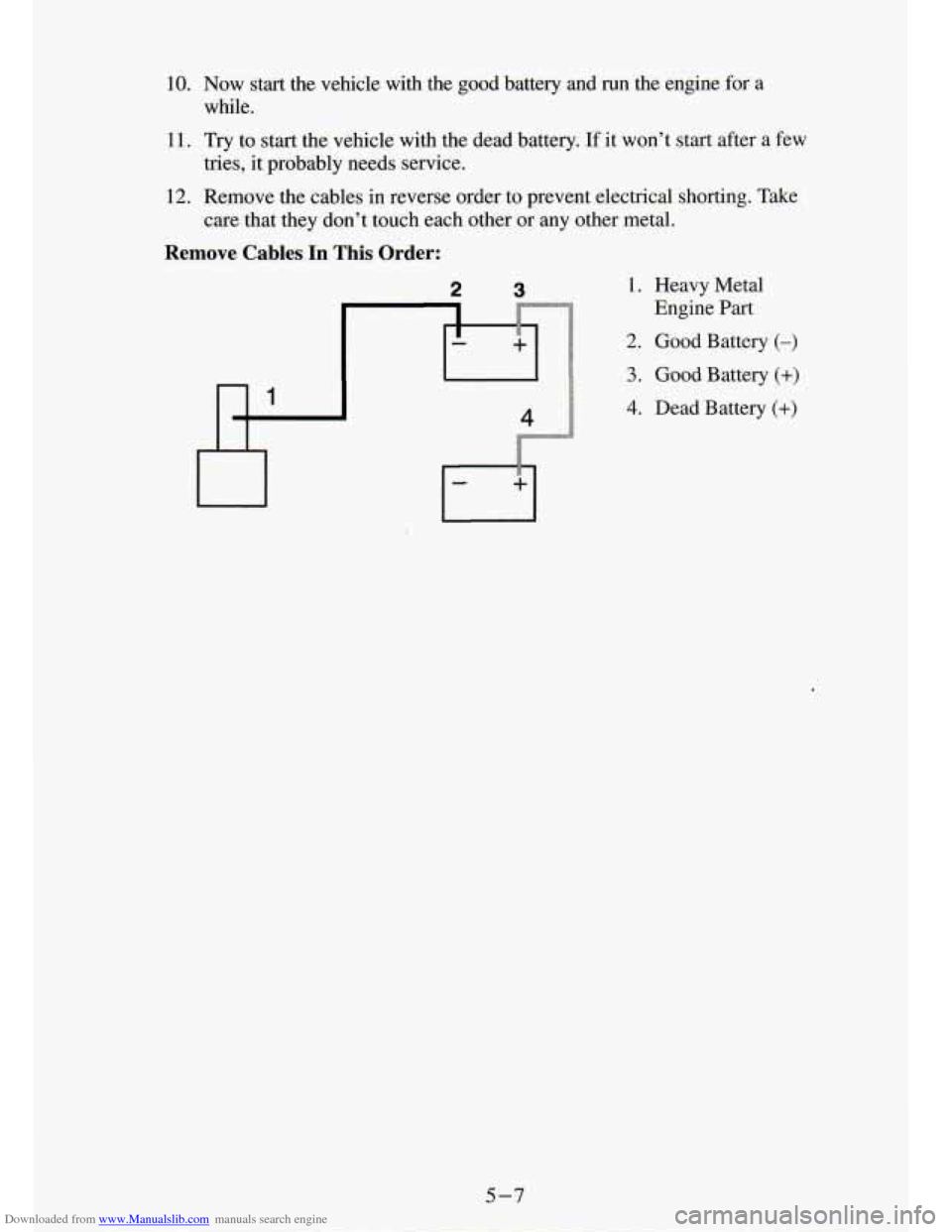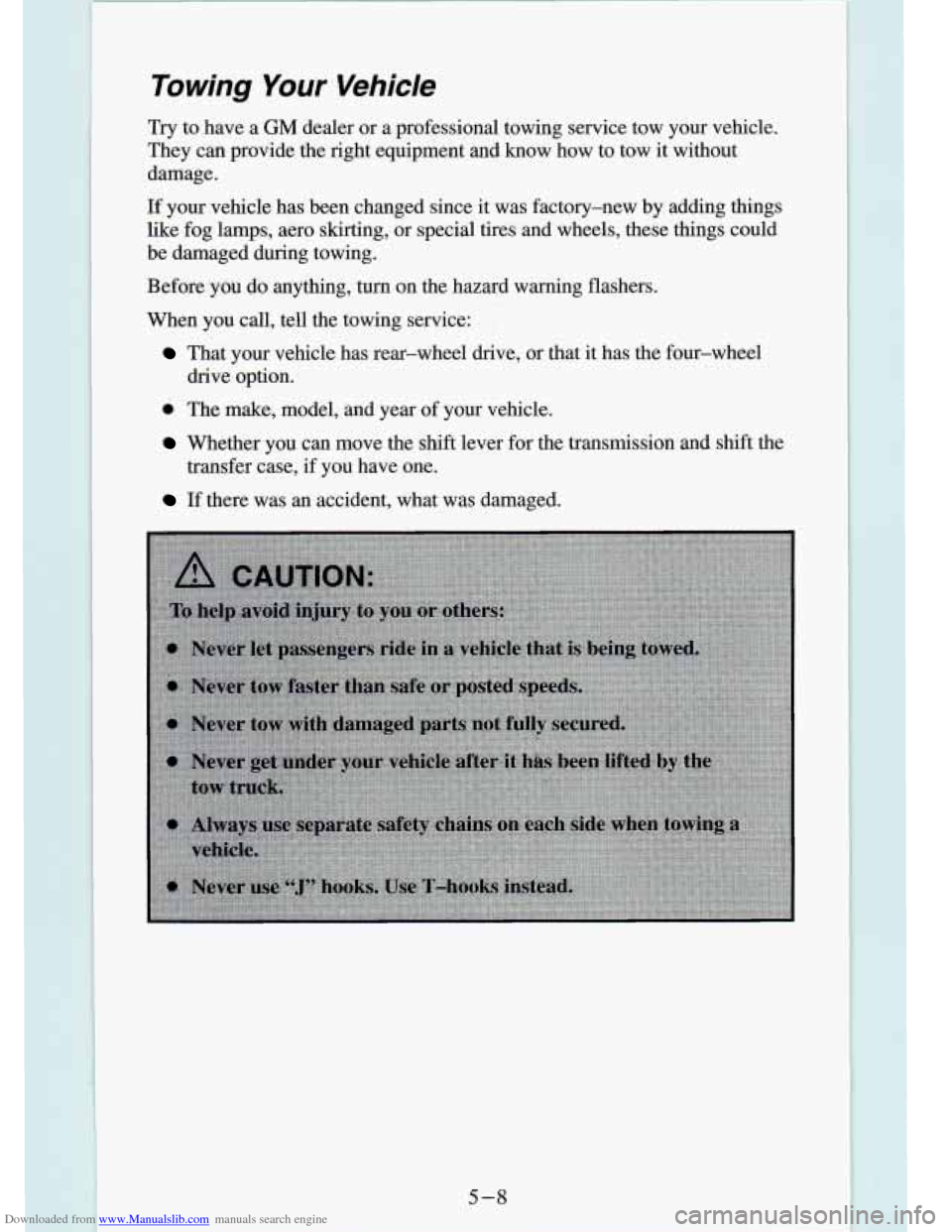CHEVROLET S10 1994 2.G Owners Manual
S10 1994 2.G
CHEVROLET
CHEVROLET
https://www.carmanualsonline.info/img/24/8266/w960_8266-0.png
CHEVROLET S10 1994 2.G Owners Manual
Trending: fuel pressure, wipers, windshield wipers, child seat, key battery, engine oil capacity, maintenance
Page 181 of 340
Downloaded from www.Manualslib.com manuals search engine Power Winches
If you wish to use a power wlncn on your vehicle, only use it when your
vehicle
is stationary or anchored.
NOTICE:
When operating a power winch on your vehicle always leave the \
transmission in the neutral position.
Do not leave an automatic
transmission in P (Park) or a manual transmission in gear or\
the
transmission may be damaged.
Use the regular brakes, set the parking brake or block the wh\
eels to keep
your vehicle from rolling.
4-45
Page 182 of 340
Downloaded from www.Manualslib.com manuals search engine Notes
4 -4t
Page 183 of 340
Downloaded from www.Manualslib.com manuals search engine Problems on the Road
Section
.
Here you’ll find what to do about some problems that can occur on the road .
Hazard Warning Flashers ..................................... 5-2
Other Warning Devices
...................................... 5-3
Jump Starting .............................................. 5-3
Towing Your Vehicle ........................................ 5-8
Engine Overheating
........................................ 5-12
If a Tire Goes Flat ......................................... 5-20
Changing a Flat Tire ....................................... 5-20
If You’re Stuck: In Sand. Mud. Ice or Snow ..................... 5-34
5-1
Page 184 of 340
Downloaded from www.Manualslib.com manuals search engine Hazard Warning Flashers
-1 Your hazard warning
flashers let you warn
others. They also let
and
off.
I police know you have a problem. Your front
and rear turn signal
lights will flash on
Press the button in to
make your front and
rear
turn signal lights
flash on and off. Your
hazard warning
flashers work no
matter what position
your key is in, and
even if the key isn’t
in.
To turn off the
flashers, pull out
on
the collar:
When the hazard warning flashers are
on, your turn signals won’t work.
Page 185 of 340
Downloaded from www.Manualslib.com manuals search engine Other Warning Devices
If you carry reflective triangles, you can set one up at the side of the road
ab.out
300 feet (100 m) behind your vehicle.
Jump Starting
If your battery has run down, you may want to use another ve\
hicle and some
jumper cables to
start your vehicle. But please follow the steps below to do
it safely.
NOTICE:
Ignoring these steps could result in costly damage to your
vehicle that wouldn’t be covered by your warranty.
Trying to start your vehicle by pushing or pulling
it could
damage your vehicle, even
if you have a manual transmission.
And
if you have an automatic transmission, it won’t start that
way.
Page 186 of 340
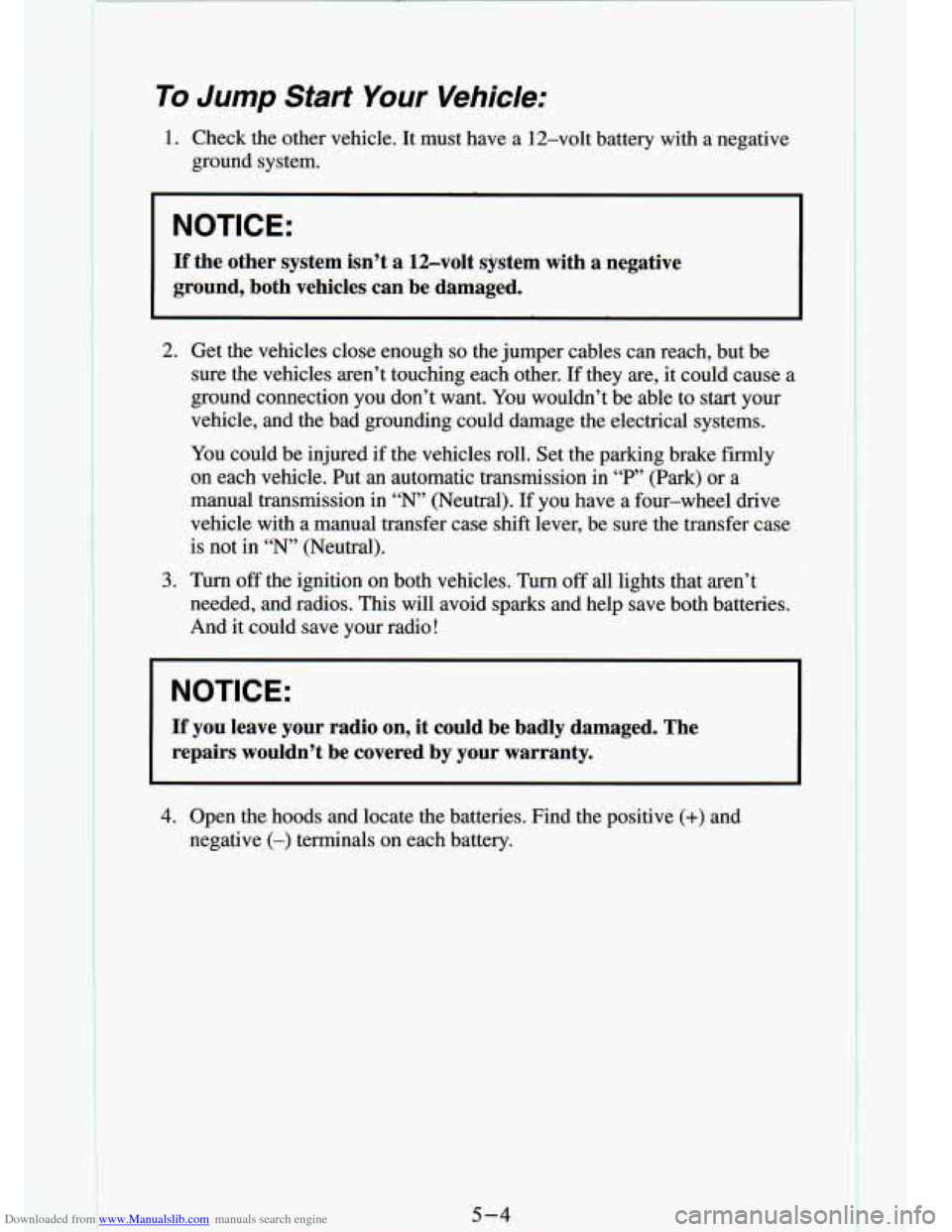
Downloaded from www.Manualslib.com manuals search engine I E
To Jump Start Your Vehicle:
1. Check the other vehicle. It must have a 12-volt battery wlm a\
negauve
ground system.
NOTICE:
If the other system isn’t a 12-volt system with a negative \
ground, both vehicles can be damaged.
2. Get the vehicles close enough so the jumper cables can reach, but be
sure the vehicles aren’t touching each other. If they are, it could cause
a
ground connection you don’t want. You wouldn’t be able to start your
vehicle, and the bad grounding could damage the electrical syst\
ems.
You could be injured if the vehicles roll, Set the parking brake
firmly
on each vehicle. Put an automatic transmission in “P” (Park)\
or a
manual transmission
in “N’ (Neutral). If you have a four-wheel drive
vehicle with
a manual transfer case shift lever, be sure the transfer case
is not in “N’ (Neutral).
3. Turn off the ignition on both vehicles. Turn off all lights t\
hat aren’t
needed, and radios. This will avoid sparks and help save both batteries.
And it could save your radio!
I NOTICE:
I
If you leave your radio on, it could be badly damaged. The
repairs wouldn’t be covered by your warranty.
4. Open the hoods and locate the batteries. Find the positive (+) and
negative
(-) terminals on each battery.
5-4
I
Page 187 of 340
Downloaded from www.Manualslib.com manuals search engine 5. Check that the jumper cables don’t have loose or missing insulation. I€
they do, you could get a shock. The vehicles could also be damaged.
Before you connect the cables, here are some basic things you should \
how. Positive (+) will go to positive (+) and negative (-) will go to
negative
(-) or SL metal engine part. Don’t. connect (+) to (-) or you’ll
get
a short that would damage the battery and maybe other parts too.
5-5
Page 188 of 340
Downloaded from www.Manualslib.com manuals search engine Dead Battery (+) Good Battery (+)
7. Don’t let the other end touch metal. Connect it to the positive (+)
terminal of the good battery.
8. Now connect the black negative (-) cable to the good battery’s negative
(-) terminal.
Don’t let the other end touch anything until the next step. The other e\
nd
of the negative cable doesn ’I go to the dead battery. It goes to a heavy
unpainted metal
part on the engine of the vehicle with the dead battery.
Good Battery (-) Heavy Metal Engine Part
9. Attach the cable at least 18 inches (45 cm) away from the dead battery,
but not near engine
parts that move. The electrical connection is just as
good there, but
the chance of sparks getting back to the battery is much
less.
5-6
Page 189 of 340
Downloaded from www.Manualslib.com manuals search engine 10. Now start the vehicle with the good battery and run the engine for a
while.
11. Try to start the vehicle with the dead battery. If it won’t start after a few
tries, it probably needs service.
12. Remove the cables in reverse order to prevent electrical shorti\
ng. Take
Remove Cables In This Order:
care that they don’t touch each otk or anv other metal.
2 3 1. Heavy Metal
2. Good Battery (-)
3. Good Battery (+)
4. Dead Battery (+)
Engine Part
5-7
Page 190 of 340
Downloaded from www.Manualslib.com manuals search engine Towing Your Vehicle
Try to have a GM dealer or a professional towing service tow your vehicle.
They can provide the right equipment and know how to tow it without
damage.
If your vehicle has been changed since
it was factory-new by adding things
like fog lamps, aero skirting, or special tires and wheels, these things\
could
be damaged during towing.
Before you do anything, turn on the hazard warning flashers.
When you call, tell the towing service:
That your vehicle has rear-wheel drive, or that it has the four-wheel
0 The make, model, and year of your vehicle.
Whether you can move the shift lever for the transmission and shift the
drive option.
transfer case, if you have one.
If there was an accident, what was damaged.
5-8
Trending: mileage, radiator cap, reset, fuel additives, clutch, service indicator, tire pressure
